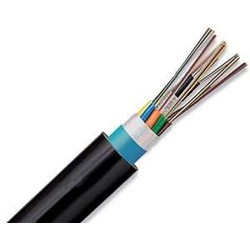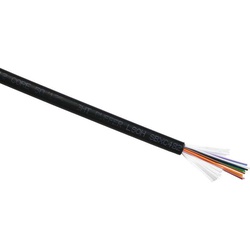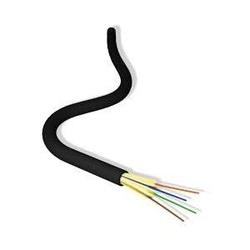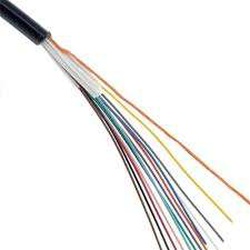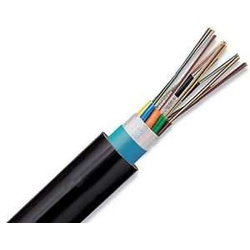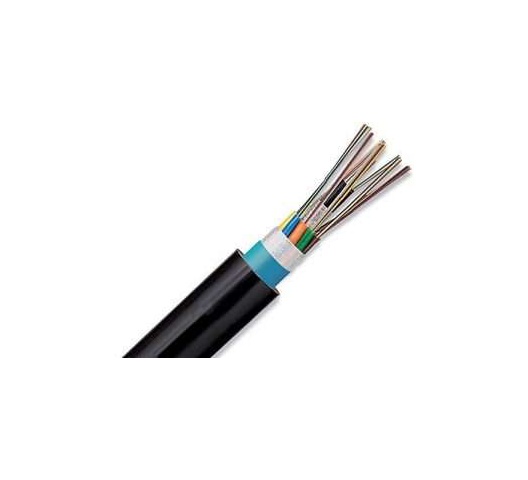
24 Core Multimode Fiber Optic Cable
by Easenet
- Cable Type: 24-Core Multimode Fiber Optic Cable
- Core Type: Multimode
- Core Count: 24 fibers
- Fiber Type:
- Core Diameter: Typically 50 µm or 62.5 µm (micrometers)
- Cladding Diameter: 125 µm (micrometers)
- Performance Standards:
- OM Rating: OM3 or OM4 (common standards for multimode fibers)
- Bandwidth:
- OM3: Up to 2 Gbps at 850 nm, 300 meters
- OM4: Up to 2 Gbps at 850 nm, 400 meters
- Transmission Wavelength:
- 850 nm: Primary wavelength for multimode fiber
- 1300 nm: Secondary wavelength for longer-distance applications
- Jacket Material:
- Outer Jacket: Typically made of PVC (Polyvinyl Chloride) or LSZH (Low Smoke Zero Halogen)
- Color: Often black or other industry-standard colors
- Fiber Construction:
- Buffer: Each fiber is individually buffered for protection
- Strength Members: Usually include aramid yarn or fiberglass for strength
- Central Strength Member: May include a fiberglass or metallic central member for additional strength
- Cable Construction:
- Type: Loose tube or tight-buffered
- Loose Tube: Fibers are housed in loose tubes that are filled with a gel or water-blocking material
- Tight-Buffered: Fibers are directly coated with a buffer layer, making them more suitable for direct termination
- Armored/Non-Armored:
- Armored: Some variants include an additional layer of protection, such as a steel armor, for enhanced durability
- Non-Armored: Standard version without extra protective layers
- Temperature Range:
- Operating Temperature: Typically -20°C to 70°C (-4°F to 158°F)
- Storage Temperature: Typically -40°C to 85°C (-40°F to 185°F)
- Bend Radius:
- Minimum Bend Radius (Installation): 10 times the outer diameter of the cable
- Minimum Bend Radius (Operation): 15 times the outer diameter of the cable
| Model Number | 24 Core |
|---|---|
| SKU | 7559 |
Reviews
This product does not have any reviews yet.
Add your reviewDescription
24 Core Multimode Fiber Optic Cable Mtech
The 24-Core Multimode Fiber Optic Cable is a high-capacity cable designed for robust data transmission in networking and telecommunications applications. This cable features 24 multimode fibers, each with a core diameter of either 50 µm or 62.5 µm and a cladding diameter of 125 µm, providing substantial bandwidth and performance for a variety of networking needs.
The cable supports high-speed data transmission with wavelengths primarily at 850 nm and, in some cases, 1300 nm. It is typically rated as OM3 or OM4 multimode fiber, where OM3 supports up to 2 Gbps at 850 nm over 300 meters, and OM4 extends this to 400 meters, making it suitable for high-bandwidth applications.
The outer jacket of the cable is usually made from durable PVC or LSZH (Low Smoke Zero Halogen) material, providing resistance to environmental factors and flame retardance. The cable may come with additional features such as aramid yarn or fiberglass for strength and protection, ensuring durability and longevity in various installation environments.
The fiber construction can be either loose tube or tight-buffered. Loose tube construction involves fibers housed in loose tubes filled with gel or water-blocking material, which offers extra protection. Tight-buffered construction features fibers that are directly coated with a buffer layer, making it more suitable for direct termination applications.
For enhanced protection, some variants of the cable are armored with a steel layer, adding an extra level of durability to safeguard against physical damage. The cable's temperature range typically spans from -20°C to 70°C (-4°F to 158°F) for operation and from -40°C to 85°C (-40°F to 185°F) for storage, making it adaptable to various environmental conditions.
The 24-Core Multimode Fiber Optic Cable is engineered to support high-performance data networks, data centers, and enterprise infrastructures, providing reliable and efficient connectivity with high bandwidth and capacity. Its construction ensures resilience and flexibility, making it a valuable component for modern high-speed network deployments.

